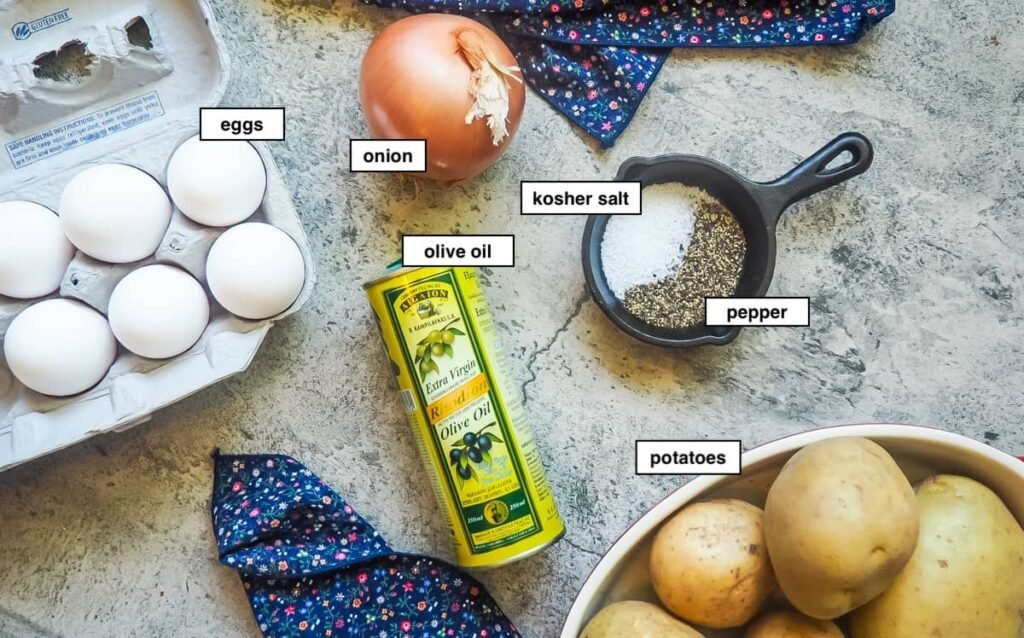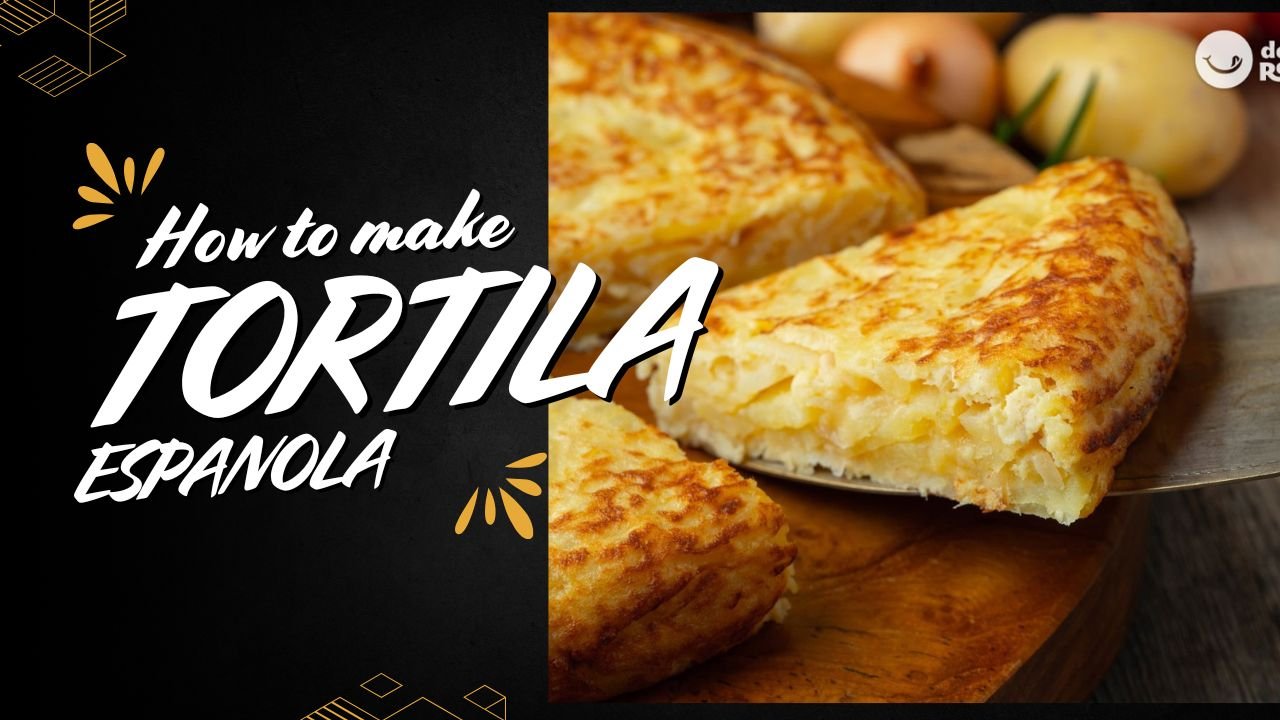Just imagine a dish that every single person in Spain loves and can eat all the time. Mostly it is super famous in every culture and also in spain. Some dishes are very satisfying, tasty and spread worldwide. It is a comfort food for many people and easy to make.
Tortilla Española, also called Spanish tortilla or tortilla de patatas. Some dishes are very satisfying, tasty and spread worldwide. A simple dish with a thick, golden omelette made with potatoes (and sometimes onions). These Simple ingredients come together to make something very special and tasty. It is a symbol of tradition, family, and the Spanish way of life.
You can find this dish everywhere in Spain. This dish is full of meaning. People can have this for lunch, dinner or a quick snack. It is perfect for every occasion. Everyone Has different styles of making this dish.
In this blog, I’ll show you how to make an authentic Tortilla Española at home, give Step-by-Step guidance, and give some tips to make this delicious dish that will be tender, rich, and full of flavour.
Table of Contents
What Is Tortilla Española?
Tortilla Española, also known as Spanish omelette or Spanish Tortilla. A traditional and popular dish. It is essentially a thick, round omelette made with eggs and potatoes. It’s often compared to an omelette or frittata.
A Good tortilla espanola has a moist, custardy interior with some bits of potatoes and onion. A Small appetizer, and you can add some variations like roasted red peppers, chorizo or fresh herbs. In Spain, it’s more than just a recipe—it’s a source of national pride.
Every family has its style to make this dish. It is easy to make at home. It has a soft, creamy interior and a lightly crisped outer layer. You will find this at every bar, cafe and in homes. Simple and transforming ingredients make it very special.
Ingredients You’ll Need
The beauty of tortillas lies in some simple yet powerful ingredients.

Essential Ingredients:
- Potatoes
- Large eggs
- Olive oil
- Salt
Optional Additions:
- Medium onion
- Fresh herbs
- Black pepper
Ingredient Needed:
- Potatoes: Potatoes are the backbone of this recipe. Waxy potatoes are often preferred. Because when they cook, it absorbs flavour and is wonderfully tender. Thinly slice or use small slices to ensure cooking.
- Eggs: Large eggs are needed. It depends on the quality of the eggs; the better the eggs, the richer the tortilla flavour and colour.
- Olive Oil: Oil is needed for cooking the potatoes and onions. This dish absorbs a lot of oil. Using high-quality extra virgin olive oil will make a noticeable difference.
- Onions (optional but traditional): Thin sliced onions are needed. Most classic recipes included onions for their sweetness.
- Salt: It is very essential for seasoning the potatoes, onions and eggs.
With Onion or Without? The Great Spanish Debate
The majority asks questions, but they prefer onions. It depends on who may ask this question.
In Spain, asking whether Tortilla Española should be made with onion or without is like asking which football team is best—everyone has a passionate opinion.
Team Con Cebolla (With Onion):
A recent survey of CIS in Spain found that 72% prefer with onion. It suggests to us this is the most classic choice for most people. People who support the onion version argue that it adds sweetness, depth, and moisture to the tortilla.
When the onion cooks slowly with the potatoes, it softens and releases its natural sugars. Many people say this is the “true” or more flavorful version.
Team Sin Cebolla (Without Onion):
Others prefer just potatoes and eggs. This version has the pure taste of the ingredients. Without the onion, the texture is a bit different, and the flavor is more focused on the potato and egg.
Try Both!
There’s no right or wrong answer to choosing an egg dish–It all just depends on personal taste. If you’re new to Tortilla Española, I recommend trying it with onion first.
Discover how to make the perfect paella with this classic Spanish recipe—authentic, flavorful, and straight from the heart of Spain.
Step-by-Step Guide: How to Make Tortilla Española
It is not difficult to make Tortilla Española. We Focus on a classic version with onions. Patience is required and especially attention to make tortillas. Here is Step-by-step guidance:
a. Prepare the Potatoes (and Onion)
- Peel the potatoes and slice them into thin y and evenly slices (about 1/8 inch or 2-3 mm thick).
- Use a similar size to the potatoes.
- Dry the Potatoes by using a paper towel to remove excess moisture in the potatoes.
b. Cook Slowly in Olive Oil
- In a large nonstick pan, heat olive oil over medium-low heat.
- Add the potatoes and onion. Coat them in oil.
- Let them cook slowly for 15–20 minutes, stirring occasionally, until the potatoes are soft but not browned or crispy.
- When it’s done, remove from the pan with a spoon and drain off the excess oil.
c. Beat the Eggs and Mix Gently
- Beat the eggs in a large bowl. Add a pinch of salt.
- Add the cooked potato and onion mixture to the eggs.
- Stir gently to combine the ingredients, but be careful not to break the potatoes too much.
- Rest the mixture for 5–10 minutes to enhance flavours.
d. Cook the Tortilla in a Pan
- Add a tablespoon of the saved olive oil to your skillet and heat it over medium heat.
- Pour it and spread the egg and potato mixture evenly.
- Cook the tortilla on medium-low heat for about 5–7 minutes until the edges look golden.
- Shake the pan gently from time to time to avoid sticking.
e. The Flip: How to Do It Safely
- Place a large flat plate or use a lid over the pan.
- Hold it tightly, and quickly flip the pan through upside down.
- Set the tortilla back into the pan and uncooked side down. Also, cook it from the other side.
- Cook for another 3–5 minutes, until it’s golden and cooked through.
Pro Tip: If flipping feels too risky, you can finish cooking it in the oven for a few minutes instead.
f. Let It Rest Before Serving
- Once cooked, take the tortilla from the pan and let it rest for about 10 minutes.
- This makes it easy to slice.
- Serve warm, at room temperature, or even cold—it tastes delicious anyway.
Tips for a Perfect Spanish Tortilla
Tortilla Española is counted in classic dishes, the little details can add a big difference. Here are some helpful tips:
1. Use Low to Medium Heat
High heat can burn it from outside. Slow cooking can make your tortilla stay tender. They are slowly cooked.
2. Don’t Overcrowd the Pan
A big pan would be easy to make. If you’re using a small skillet, reduce the ingredient amounts. It would not cook evenly in the centre. Our goal for a good thickness is about 1 to 1.5 inches (2.5 to 4 cm).
3. Let the Potatoes Cool Slightly Before Adding to Eggs
Eggs can be warm, not hot. Otherwise, they may scramble them. Let them cool for just a few minutes. That helps you to achieve a smooth texture.
4. Season in Layers
Lightly season the potatoes while cooking and again when mixing with the eggs. This ensures flavour throughout the tortilla—not just on the surface.
5. Flip with Confidence
The flip is the trickiest part and uses a lid. Use a plate that is slightly larger than your pan, hold it firmly, and flip quickly but smoothly. If you’re nervous, you can finish the tortilla in the oven under a broiler for a couple of minutes instead.
How to Serve Tortilla Española
A Common Way to Enjoy Tortilla. You can enjoy it hot, cold, or at room temperature—and it’s just so delicious.
Hot, Cold, or Room Temp?
- Hot: You can serve it warm. Rest for about 10-15 minutes after cooking to allow it to set. Fresh from the pan, warm and comforting—perfect as a main meal.
- Room Temperature: Most traditional way To Serve in Spain, especially when served as a tapa. Let the flavour melt and the texture set up perfectly.
- Cold: It is a delicious cold, a fantastic option for picnics. Great for leftovers or packed lunches, and surprisingly flavorful!
Serve It as a Tapa
You can serve this as an appetizer; it is the iconic way. Cut the tortilla into small cubes or wedges, insert toothpicks, and serve as part of a Spanish tapas spread. You can add olives, cheese, or jamón for an authentic experience.
Make a Bocadillo (Tortilla Sandwich)
It is a very popular way to serve tortillas. Place a thick slice of tortilla inside a crusty baguette to make a bocadillo de tortilla—a favourite Spanish snack or lunch. Simple, satisfying, and perfect on the go.
Pairing Ideas
- Salad
- Bread
- Wine
Variations to Try
A masterpiece of eggs, potatoes and often onion. These allow for more variations. There are countless creative variations you can try in making tortillas, whether you want to add meats, veggies, mushrooms, or cheese.
Tasty Add-ins to Experiment With:

- Chorizo: A Very popular addition.Adds a smoky, spicy kick. Saute diced chorizo with the potatoes and onions.
- Bell Peppers: Saute diced red, green, or yellow bell Peppers. It adds Sweetness, flavour and colour.
- Cheese: A handful of grated Manchego, cheddar, or goat cheese gives a creamy, rich texture and complements the potatoes well.
- Spinach or Kale: Lightly sauté greens for a healthy and flavorful addition. Stir them into the egg mix for added nutrients.
- Zucchini, Mushrooms, or Leeks: Great for a veggie-packed twist—cook them first to reduce moisture and enjoy it.
Regional Twists from Across Spain:
- Tortilla de Betanzos: Super runny and creamy from the inside.
- Tortilla Paisana: Includes veggies like peas and red pepper, and sometimes even ham.
- Andalusian Style: Often includes garlic or herbs like parsley for extra aroma and flavour.
Every region (and family) has its secret ingredient!
Modern and Dietary-Friendly Versions:
- Vegan Tortilla: Replace eggs with chickpea flour and water or silken tofu—still tasty and satisfying.
- Oven-Baked Tortilla: Instead of frying, pour the egg and potato mixture into a greased baking dish and bake at 180°C (350°F) until set. Easier and less oil-heavy.
- Low-Oil Option: Steam or roast the potatoes instead of frying them to reduce oil content.
Storage Tips
Tortilla Española is one of those rare dishes that are just as good the next day—maybe even better! You can store it beautifully, and it travels well with this. Here are some pr tips:
How to Store Leftovers
- Let the tortilla cool to room temperature before storing.
- Use an airtight container. It is stored properly in the refrigerator for upto 3-4 days.
- Freezing is an optional choice.
Can You Freeze It?
Yes, but with some care.
- Wrap the tortilla in plastic wrap, then foil.
- Freeze for up to 1 month.
- Avoid microwaving from frozen—it can become rubbery.
Keep in mind: Freezing may slightly change the texture, especially if the centre is very soft, but it still tastes great!
Best Ways to Reheat Without Drying Out
- Skillet: The best method is skillet. Heat a nonstick pan over low heat with a touch of olive oil. Cover a pan with a lid and warm gently on each side for a few minutes.
- Oven: Wrap the tortilla in foil and reheat at 160°C (325°F) for about 10–15 minutes.
- Microwave: Use only for small portions, and reheat in short bursts (20–30 seconds) to avoid overcooking. Avoid high heat or reheat many times.
Conclusion
Tortilla Española is more than just a dish—it’s a symbol of Spanish identity, simplicity, and heart. With just a few humble ingredients, it creates something incredibly flavorful, comforting, and endlessly versatile.
Whether you enjoy it warm with a glass of wine, packed in a picnic sandwich, or sliced into tapas for guests, Tortilla Española fits almost any moment. It’s easy to make and even easier to love, and once you’ve tried it, you’ll understand why it’s Spain’s most beloved dish.
So go ahead—gather your potatoes, crack the eggs, and bring a bit of Spain taste into your kitchen. You don’t need to be a chef to enjoy this delicious dish. Just cook with care and confidence, and let the ingredients speak for themselves. Tortilla Española is endlessly adaptable—feel free to make it your while still honoring its Spanish roots! Make it ahead, store it right, and enjoy it anytime!










